After months of speculation behind Project Magi, Google has officially unveiled its new search generative experience (SGE) at the Google I/O event on May 10, 2023.
Google is betting on AI to lead the way in Search. But it’s not just about chatbots.
The iconic search engine isn’t all about chatbots (although it’s working on a chatbot project called Bard). It’s not just about revamping its homepage to resemble ChatGPT‘s messaging interface.
Instead, Google is putting AI at the heart of the most valuable space on the internet: its current search results.
Let’s get to know more about this new experiment.
What is Google Search Generative Experience?
Search generative experience, or SGE, is a limited beta version of Google using LLM (large language models) to generate contextual & conversational snapshot answers to complex questions in search results. Google has named this new interactive & chat-based engine a search generative experience (SGE). It features
- AI snapshot,
- Conversational mode,
- Vertical experiences,
- Ask a follow-up question.
Unlike traditional search experience, generative AI aims to assist, complement, empower, and inspire users.
-

A look at what’s next for AI and Google Search | Google I/O 2023
For over a decade, AI has been behind the evolution of Search. This is a glimpse at how generative AI will further evolve Search in the coming months. This new Search Generative Experience, also known as SGE, will be rolling out via our Search Labs program: https://g.co/Labs. Starting today, if you’re in the US, you can join the waitlist by tapping the Labs icon in the latest version of the Google app or Chrome desktop.Audio described version here: https://youtu.be/_MA7vuWMqZY
For a quick recap of Google I/O, check out this video: https://youtu.be/QpBTM0GO6xI
Subscribe to our Channel: https://www.youtube.com/google
Tweet with us on Twitter: https://twitter.com/google
Follow us on Instagram: https://www.instagram.com/google
Join us on Facebook: https://www.facebook.com/Google
You can converse, get AI-powered briefs and even ask a follow-up question, no need to open hundreds of tabs to research any topic.
How does Google Search Generative Experience (SGE) work?
SGE aims to improve the search experience by enriching search queries with more context and information through the use of generative AI. By understanding topics better, uncovering new insights, and making the process easier, SGE improves the search for the end user.
It’s still early days for conversational search, but most people know this could affect how often people scroll down to find organic links or sponsored content as they already have summarized answers to their questions.
-
AI-Powered Snapshots
SGE displays an AI-driven snapshot ( “snapshot,” as Google likes to call it) to provide users with a quick summary of factors to take into account and a helpful overview of appropriate insights and information (although this is not true for every & every query).
These snapshots act as a starting point for users to explore a wide variety of content and views across the web.
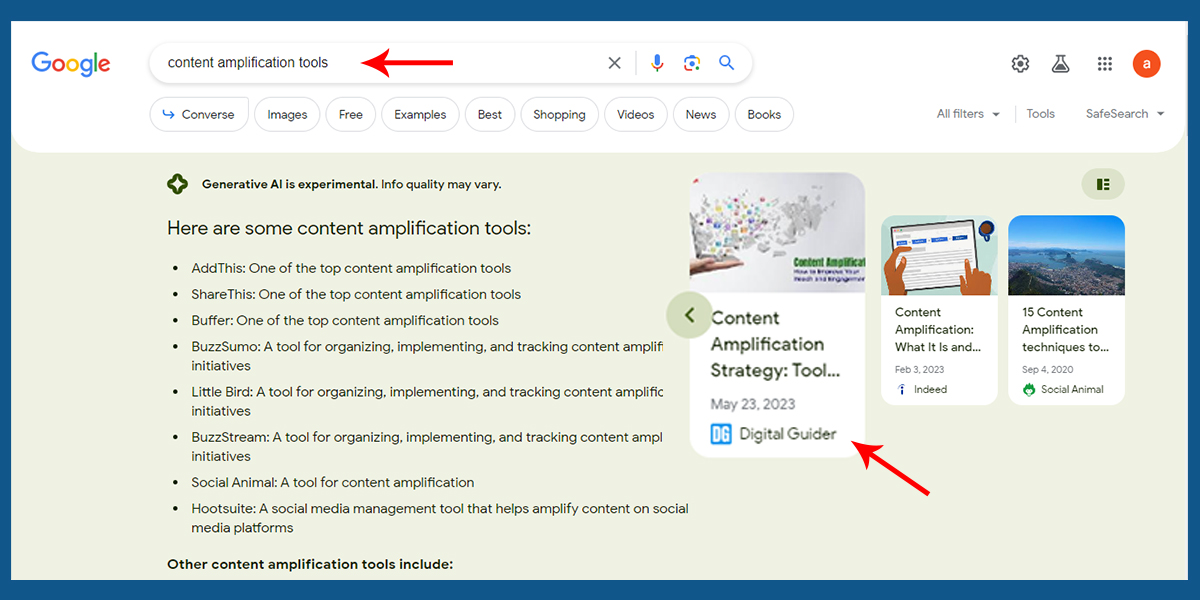
SGE will then display links to sources/websites that confirm the information in a snapshot, allowing users to check the information on their own and dig deeper, which also features our blog on content amplification strategies. This will enable users to explore various content.
-
More Personalized & Conversational SERPs
Need to ask more questions on any specific topics?
With SGE, you don’t need to open hundreds of tabs to ask each question; you can just ask a follow-up question under the snapshot. Under the snapshot, you can tap “Ask a follow-up.”
This will open a new “conversation mode,” where you naturally ask Google SGE more questions about the topic you’re looking at. In addition to the short snippets of AI-generated data, you can also ask for additional links to resources you want to look at.
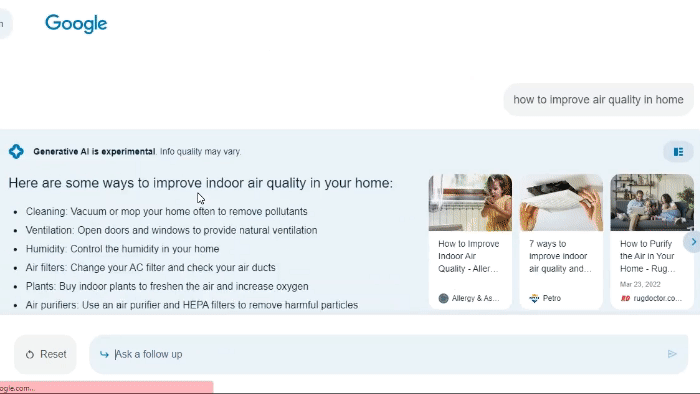
The conversational mode works best for follow-up queries and more complex or changing information journeys. It relies on AI to recognize when a user is looking for something related to a previous query. It carries over context from previous queries to rephrase the query to match the user’s intent better.
In conversational mode, users can view their web links below the SGE change throughout the conversation, allowing them to easily explore the most relevant content from all over the web.
When we asked SGE a follow-up question about “ affordable air purifier options,” it presented us with product links that surfaced during that conversational search. This indicates a golden opportunity for businesses.
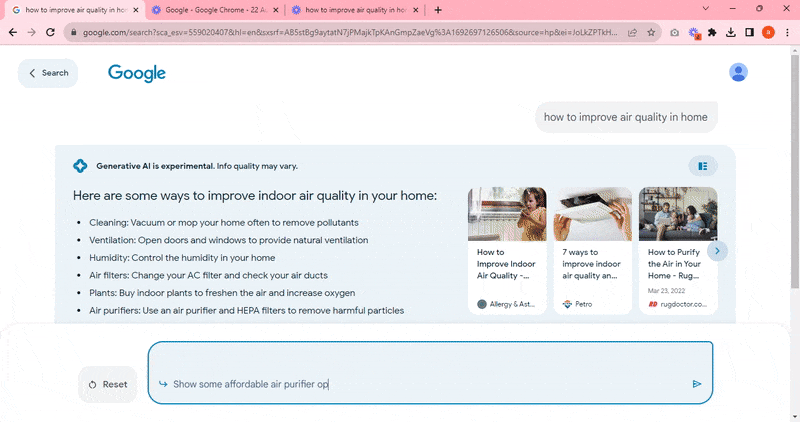
If your content is optimized for conversational types of searches, you could get more qualified traffic and,d obviously, AI-powered snapshots.
Recommended Read: Content Amplification: Improve Your Content’s Reach and Engagement
-
Local Pack Results & Product Searches
SGE is helpful for information journeys related to verticals like shopping and local searches.
It helps uncover insights for complex purchase decisions and provides relevant product descriptions. Using AI-powered insights, SGE is built on Google’s Shopping Graph and provides context about local places. It generates a snapshot of noteworthy factors and a range of product options.
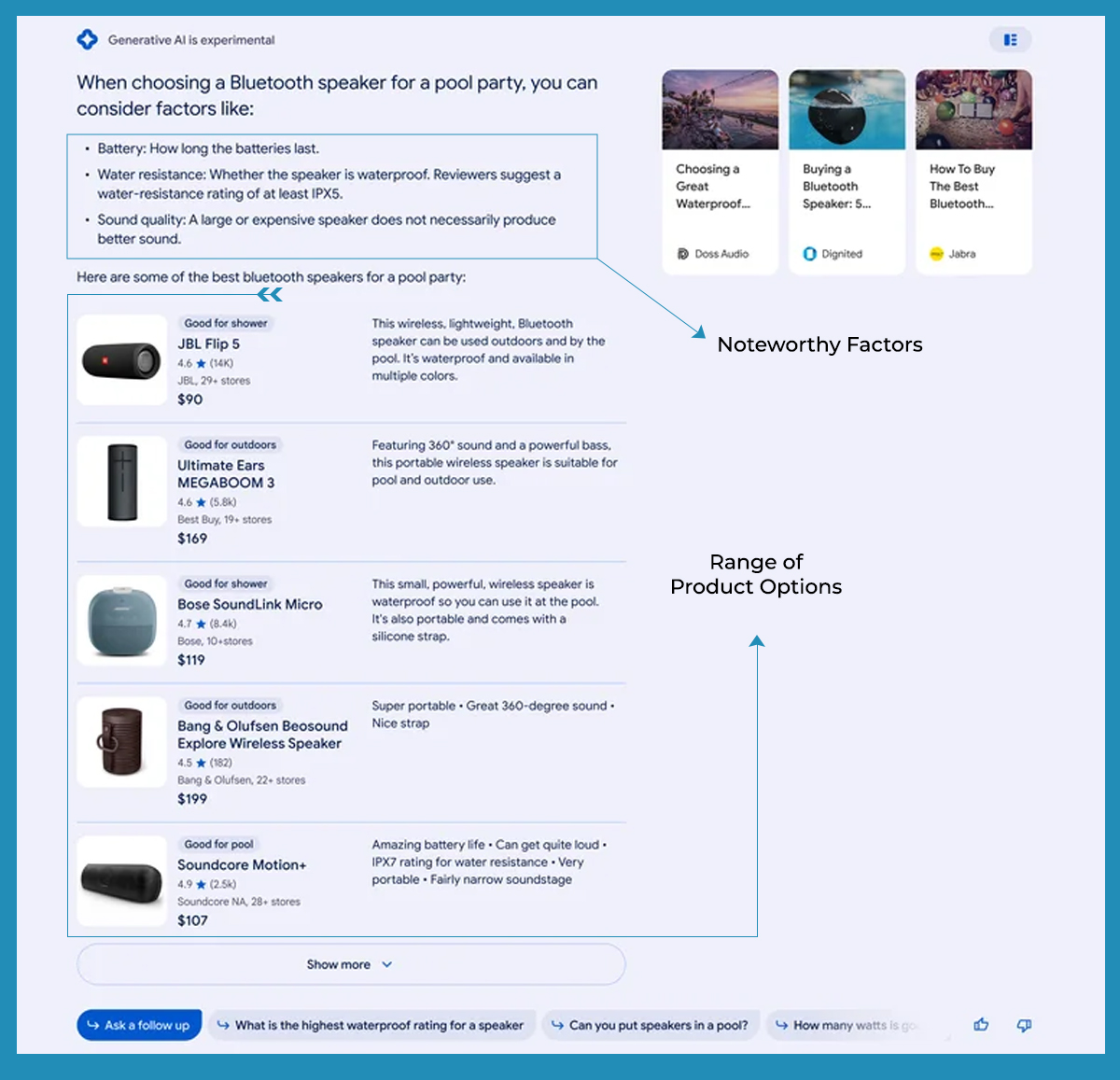
Google has emphasized vertical experiences, including local search. Google said, “SGE will provide context about local places, using AI-powered insights that make it easy to compare and explore options.”
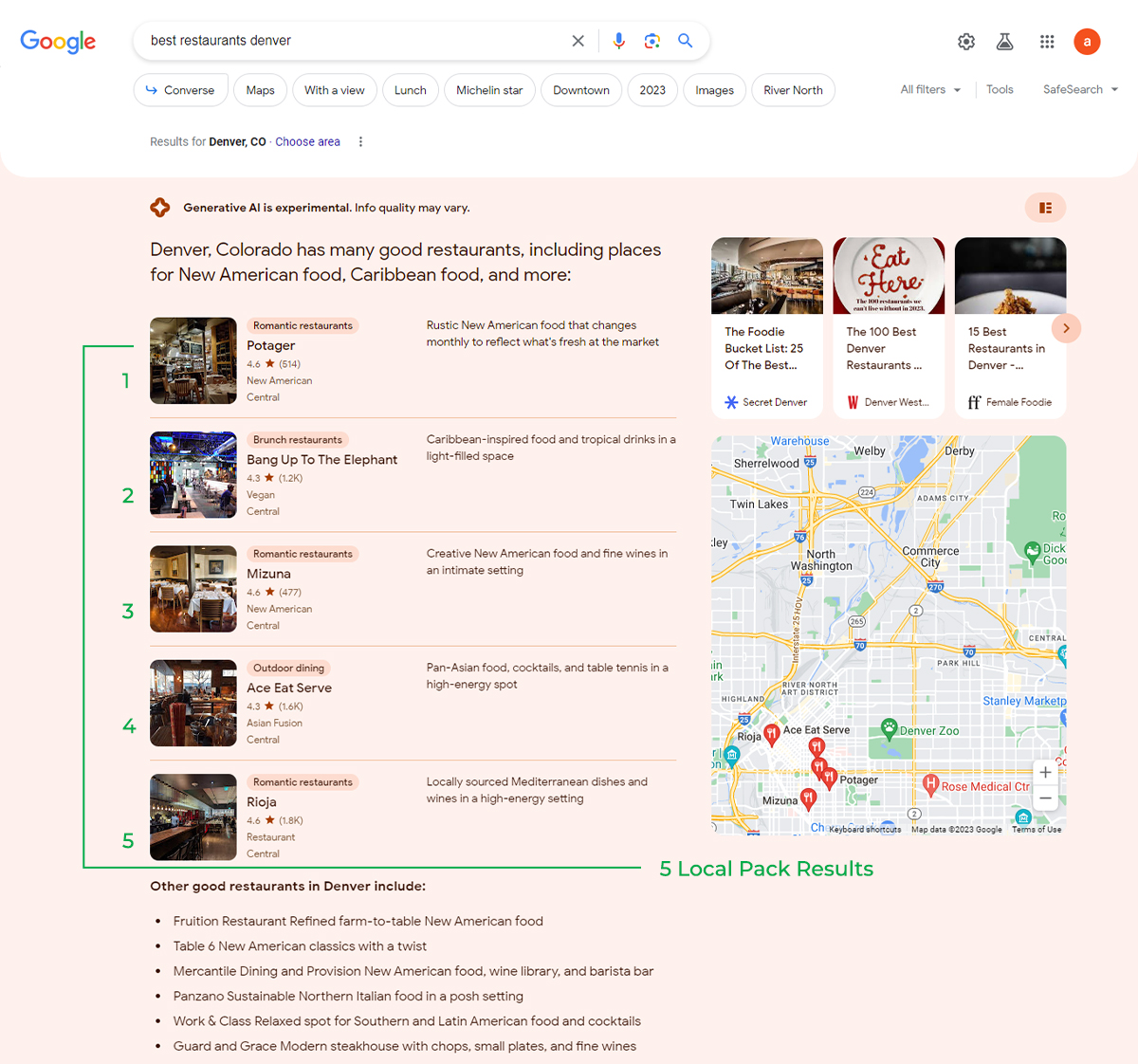
The most interesting thing to observe here is that SGE Results show a 5-pack instead of the existing 3-local pack. The 5-pack has a short description next to each pack result; this sometimes includes reviews.
As seen above, local business listing results pulled up by SGE show business descriptions, images, and reviews in results. Therefore, It is best to keep your listings optimized and your business as visible in organic listings as possible.
-
Sponsored Ads
In shopping, google search generative AI helps you uncover insights to make decisions quickly and easily. The snapshots will show you a bunch of important factors to think about and a bunch of different product options. Plus, it’ll give you product descriptions with all the info you need, like reviews, ratings, prices, and product images.

SGE is based on Google’s Shopping Graph, which is like the world’s most enormous dataset of constantly changing stuff. With SGE, ads will still show up in dedicated ad slots throughout the page, so advertisers still have the chance to reach potential customers along their search journey.
Learn more: What is Click Fraud? 6 Best Click Fraud Detection Tools
How Does Search Generative Experience Affect SEO?
As SGE aggregates data from multiple sources into a single summary, users will be asked fewer queries to find answers to their questions. As a result, they are less inclined to scroll down the SERPs to explore other websites.
Since BERT and RankBrain, search generative experience will probably be the most significant algorithm update of Google. ( if it is accessible worldwide, currently, it is a beta version, available to the U.S.A only )
This update may completely change what we know about click-through rates using traditional search. Generative AI can be the real game-changer when it comes to understanding technical concepts and summarizing key points in an intuitive way.
Generally speaking, one-sentence questions and sensitive questions are two types of questions that AI can’t answer for the most part.
Searches that do not trigger an AI response in SGE include:
- Quick answers such as weather, date, song lyrics, etc.
- Navigation queries such as brand names where the user just wants a link to the primary website do not typically trigger an AI response.
- Recipes appear to be absent at this time.
- Sensitive queries such as gender identity, the Holocaust, etc.
- Health and financial queries (YMYL)
- Current news and events, things happening “now,” are excluded.
These categories are popular. While they account for less than 70% of the total queries, it’s not hard to imagine that they account for a significant portion of Google’s ~8.5 billion daily queries.
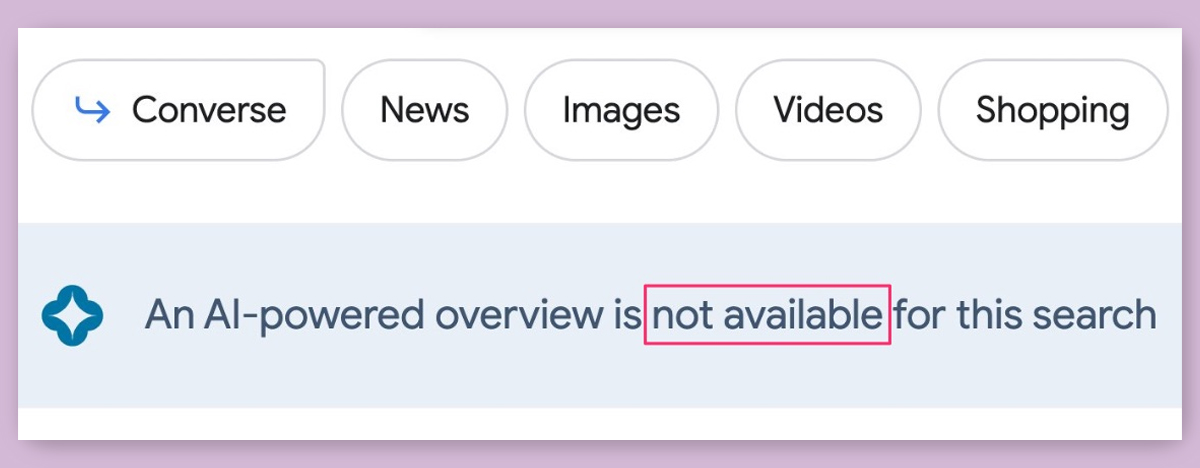
But the big question is: will organic traffic, featured snippets, and PPA become the norm if SGE is implemented correctly?
Many SEO experts have said approximately 70% of the queries don’t trigger an AI answer; we have also observed the same. It is unlikely that search generative experience will harm your website’s SEO or organic traffic( but there is a catch).
But as shown in the GIF about selecting a yoga mat, you can see that on clicking any particular video, there are multiple sources for purchasing the mat with price comparisons & reviews of verified customers.
In the beta version of SGE, various SERP elements, including featured snippets, are still included in the SERP. Notably, featured snippets have been observed to be placed directly beneath the AI snippets. This may appear counterintuitive as both of them provide a concise summary of the subject matter.
One can’t trust AI completely; Google’s AI-driven reactions are no different.
For instance, when Cypus Shephard ( SEO strategist at Moz & founder of Zyppy) asked about how to boil an egg, it suggested that you boil the eggs for a total of 60 minutes.
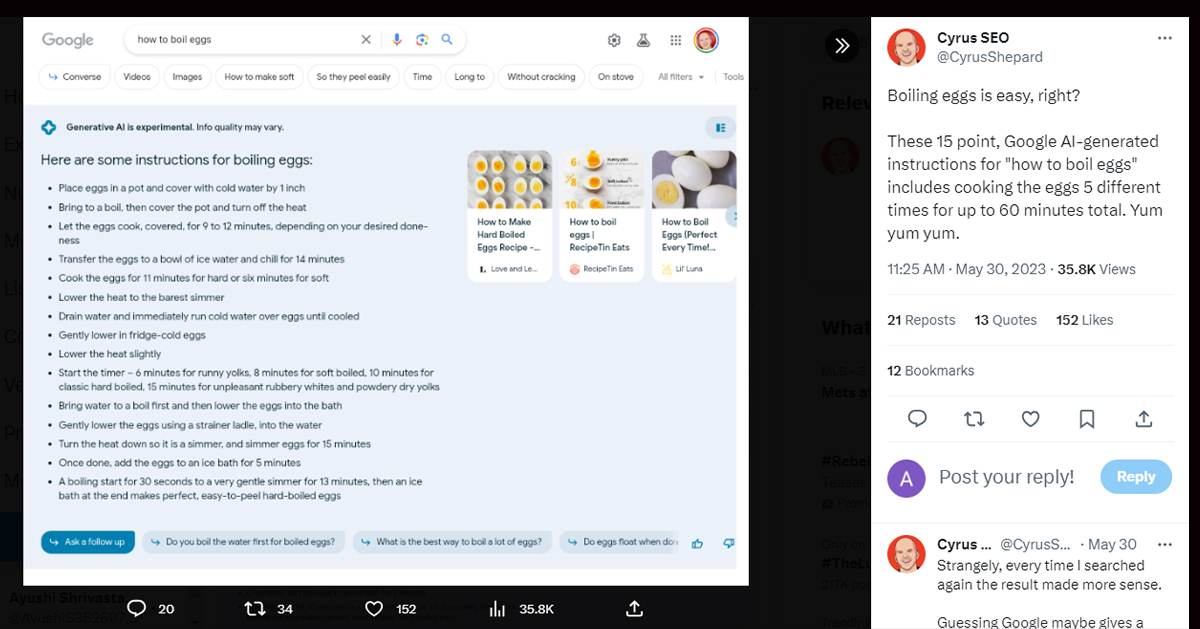
With the help of Generative AI, Google aims to make the user experience of searching or shopping more seamless & helpful.
The snapshots provided by SGE are only corroborated by multiple blogs and articles. So if your website has-
- Informational content fulfilling the searcher’s intent.
- Conversational content
- In-depth information on the particular topic
- Follows E-E-A-T guidelines for YMYL topics.
Then you need not worry about SGE hurting your organic traffic.
Moreover, SGE can prove to be good news for ecommerce businesses; if a shopper learns how to narrow their search before they click, they’re more likely to be a higher-intent buyer before they even get to your site. In that case, SGE works like a salesperson that helps shoppers qualify before they even set foot in your store.
Must Read for Business Owners: Omnichannel Vs. Multichannel Marketing – Which Is The Best Marketing Approach?
How to access Google Search Generative Experience?
Currently, SGE is only accessible in the U.S.A, as it is still on a trial basis. SGE can only be accessed if you have signed up for Search Labs.
Here’s a step to step guide to accessing Google’s SGE-
- First, you must sign up/join the waitlist for Search Labs. This may take some time.
- Remember to use a personal Google account; a Google Workspace account will not work here.
- After accessing Search Labs, turn on SGE for search & browsing.
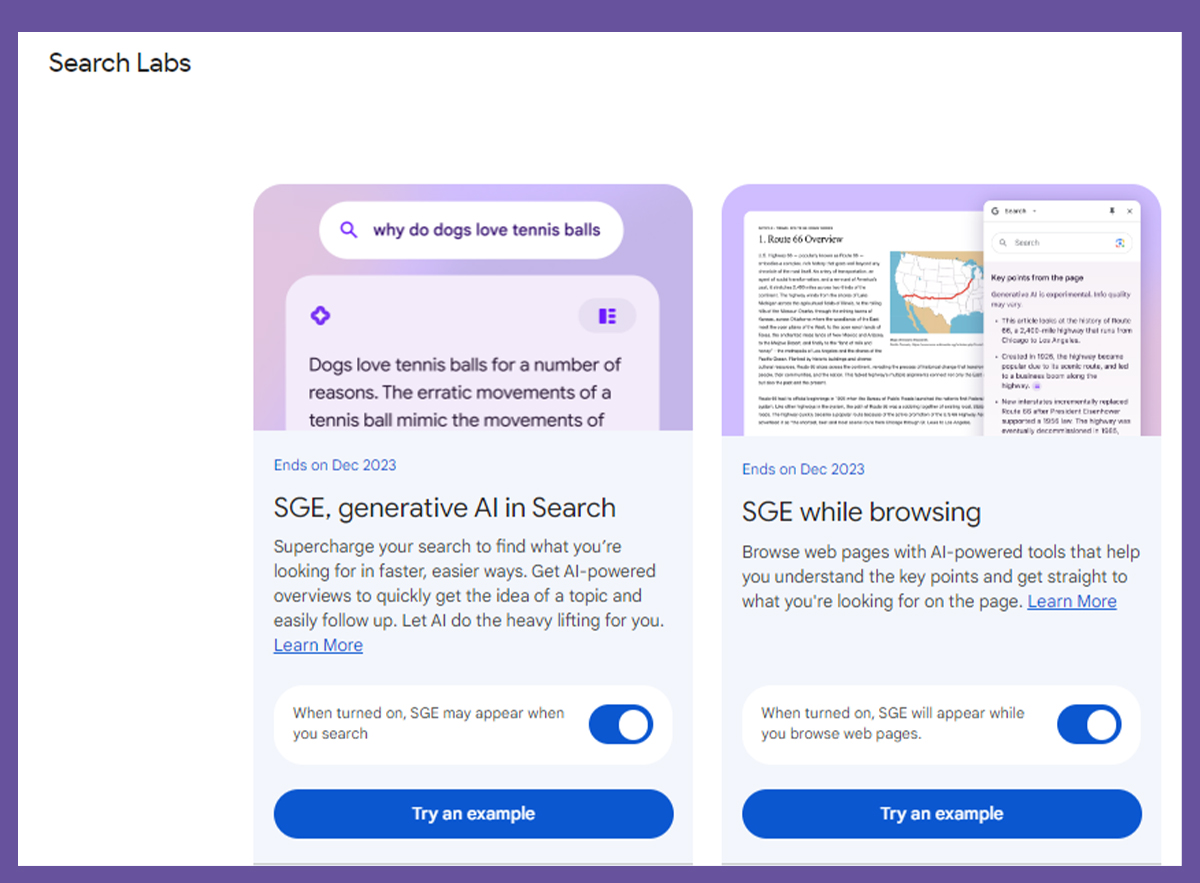
- Ensure you’re signed in to your Google Account with “Incognito mode” turned off and SGE turned on.
- Start experiencing the new era of generative search AI & personalization!
Note : The beta version of Google’s SGE is available till Dec. 2023
https://www.seroundtable.com/google-search-generative-experience-ends-december-2023-35463.html
Wrapping up – How To Prepare For SGE?
As more companies embrace AI and continue to see a surge in content competition and AI-driven SERPs, there’s no need to panic. In fact, it’s actually a great opportunity for all of us to step back and think about what we create, where we create it, and how we can improve it.
Please note SGE is a work in progress, and the triggers for AI Snapshot may evolve over time. Therefore, optimizing for AI search may not be necessary now, but it may be worth it.
For the time being, the best way to do this is to register for Search Labs and sign up for the SGE waitlist. Once you’re on the waitlist, if you notice a significant change in your campaign’s results, you can confirm that it’s the SGE treatment for a keyword.
The post Google Search Generative Experience- Personalized SERP & Effects On SEO appeared first on DigitalGuider.
Source: digitalguider.com




